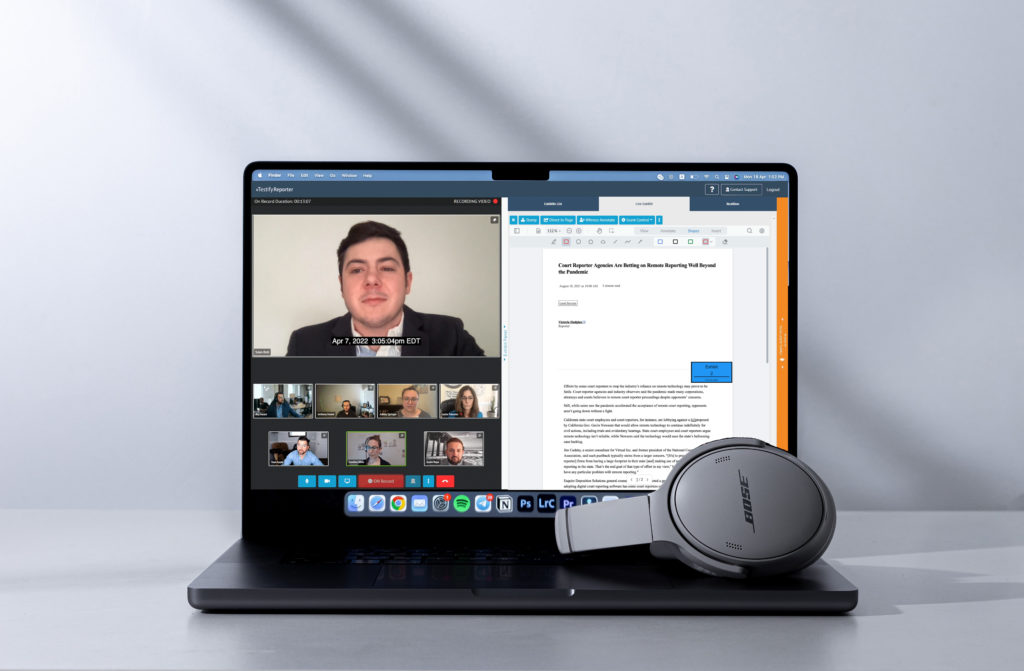The Modernization of Court Reporting: Videographer Interview
In our previous segment of the modernization blogs, The Modernization of the Court Reporting Agencies: The Videographer, we analyzed the journey the legal videographer has taken through the last several decades. From early beginnings, through 2020 and to their current state, the legal videographer has experienced a vast number of changes in technology and their daily workflow. To learn more about the daily professional lives of the modern videographer, we connected with two industry insiders, Austin and Ryan Parker, that shared their opinions and stories with us. Working as part of the video team for GPS, LLC, the experiences they were able to share with us shed even more light on where the videographer industry is right now, and where they feel it’s headed in the near future.

Fully Remote vs. In-person vs. Hybrid
There has been a gradual rise of in-person depositions after all depositions switched to remote in 2020. While it varies from state to state, Austin and Ryan were able to provide estimates from their experience of 60% for fully remote, 30% for in person, and 10% for hybrid depositions in the State of Texas. Most attorneys seem to have chosen one of these methods and consistently stick to it, making hybrid the least popular. However, many in-room depositions will require a laptop to be taken for someone to join virtually, so the popularity with hybrid does seem to be rising.
Moreover, many attorneys choose one of the above-mentioned methods depending on the type of case they are litigating. For example, the larger cases, such as construction defect and asbestos, tend to lean towards the in-person workflow. However, even with the increasing popularity of in-person and hybrid depositions, at least 60% of GPS’s depositions remain fully remote.
The Benefits of Videotaped Remote Depositions
Prior to the pandemic, only a small percentage of depositions were conducted remotely. During the lockdowns, however, the benefits of handling depositions this way were revealed, and most of the industry has never looked back. Austin and Ryan experienced these benefits immediately. Not having to travel long distances increased their efficiency; they are now able take more depositions for their clients as the demand for video rises. There have also been some physical advantages to moving to remote as well. While their equipment has certainly slimmed down in size over the years, there is still bulky equipment to transport and set up. Having recording options for depositions at their fingertips keeps the modern videographer on task as they spend less time moving around.
Remote depositions can also leverage digital equipment to bring more services to court reporting clients. Since the transition, ordering picture-in-picture recording has become more popular among attorneys, according to Austin and Ryan. On site, they utilize equipment such as a digital ELMO to show a physical exhibit on camera and have a side-by-side image while recording the witness’s reaction to what they are seeing or reading. These upgraded services increase the reporting firm’s revenue stream and provide clients with an advantage to help them win their case in court.
Professional Attendance
While videographers have flourished during the remote era, this style of recording has brought its own set of challenges. Not being in the same room as a witness means that the videographer has less control of the quality of the video. Austin and Ryan would like to see witnesses being informed of minimum requirements prior to the deposition date to ensure the best possible video-recorded testimony. A strong Wi-Fi connection matched with an updated computer is the most important necessity for a clear video that can be used in court.
Witnesses should also be mindful of where they are giving their testimony. They shared that there have been depositions where a witness appeared from her car — even driving — while giving testimony. These less-than-optimal conditions make it very difficult for a videographer to provide court-ready deliverables to their clients.
Other conditions to consider are lighting, backgrounds, and positioning when taking a deposition. Poor lighting conditions will affect the quality of a final product, making the video appear grainy and dark. There is also a preference to not use virtual backgrounds for witnesses that are being recorded. Virtual backgrounds can obscure and blur parts of the witness’s face and body, and it’s imperative that the camera remains focused on the witness throughout the entire proceeding. Therefore, a well-lit room with the light source in front of the witness, as well as a natural background with limited objects behind them, is the gold standard for a professional appearance. A strong internet connection and newer computer generates the optimal recording for your case.

Andre Rojas
Andre Rojas is the Director of Virtual Solutions at vTestify. He brings his 14 years of experience in the court reporting field and is responsible for maintaining operational excellence and ensuring customer satisfaction.
